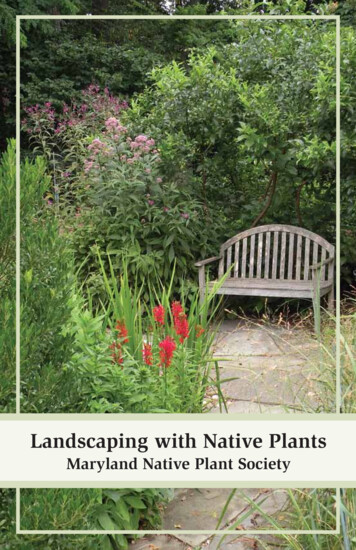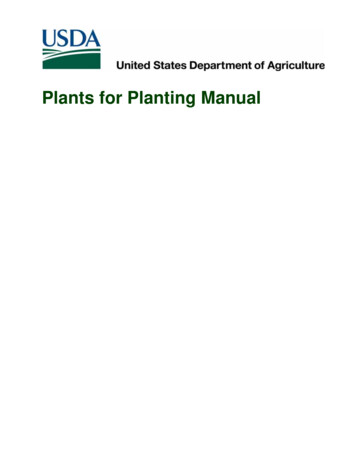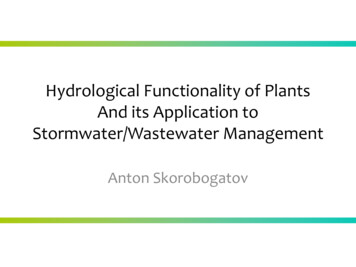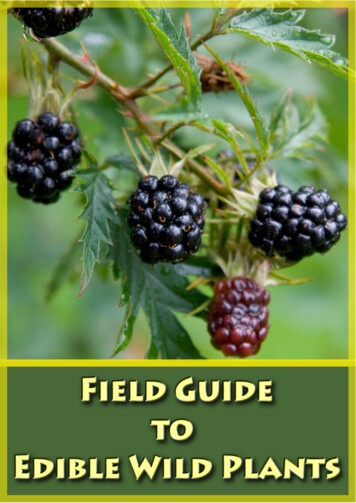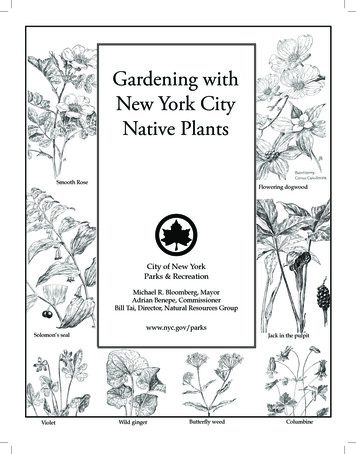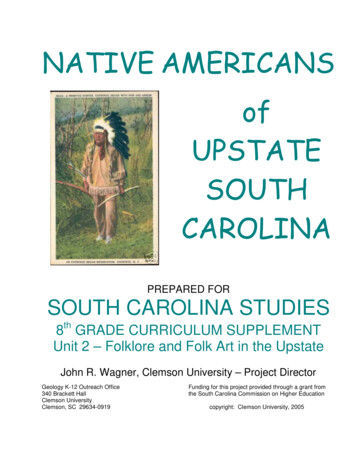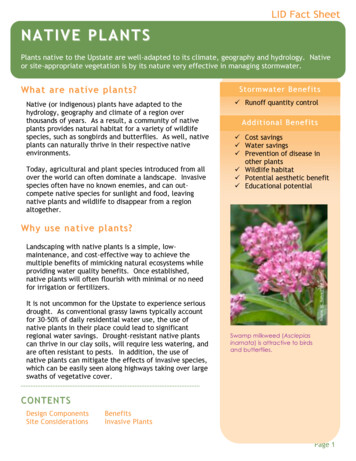
Transcription
NATIVE PLANTSPlants native to the Upstate are well-adapted to its climate, geography and hydrology. Nativeor site-appropriate vegetation is by its nature very effective in managing stormwater.What are native plants?Native (or indigenous) plants have adapted to thehydrology, geography and climate of a region overthousands of years. As a result, a community of nativeplants provides natural habitat for a variety of wildlifespecies, such as songbirds and butterflies. As well, nativeplants can naturally thrive in their respective nativeenvironments.Today, agricultural and plant species introduced from allover the world can often dominate a landscape. Invasivespecies often have no known enemies, and can outcompete native species for sunlight and food, leavingnative plants and wildlife to disappear from a regionaltogether.Stormwater Benefits! Runoff quantity controlAdditional Benefits! Cost savings! Water savings! Prevention of disease inother plants! Wildlife habitat! Potential aesthetic benefit! Educational potentialWhy use native plants?It is not uncommon for the Upstate to experience seriousdrought. As conventional grassy lawns typically accountfor 30-50% of daily residential water use, the use ofnative plants in their place could lead to significantregional water savings. Drought-resistant native plantscan thrive in our clay soils, will require less watering, andare often resistant to pests. In addition, the use ofnative plants can mitigate the effects of invasive species,which can be easily seen along highways taking over largeswaths of vegetative cover.Source: SC Native Plant SocietyLandscaping with native plants is a simple, lowmaintenance, and cost-effective way to achieve themultiple benefits of mimicking natural ecosystems whileproviding water quality benefits. Once established,native plants will often flourish with minimal or no needfor irrigation or fertilizers.Swamp milkweed (Asclepiasinarnata) is attractive to birdsand butterflies.CONTENTSDesign ComponentsSite ConsiderationsBenefitsInvasive PlantsPage 1
DESIGN COMPONENTSSource: SC Native Plant SocietyAttractive Plant Species Indigenous to theUpstateReplacing mowed lawns withnative landscapesThere is no need to limit native plant use to LIDtechniques. In order to perform importantecological functions, native vegetation should bepreserved wherever possible, and native plantsshould be employed wherever landscaping isdesired. The use of native species is not aslimiting as some might suppose – one school sitein Spartanburg uses about 4,000 native species.Native landscaping provides many design optionsand in addition to being aesthetically pleasing,native plants improve local biodiversity.Clockwise from left:Azaleas, butterflymilkweed, cinnamon fern,and bleeding heart(Dicentra spectabilis)Conventional lawn maintenance accounts for alarge portion of residential water use, and assuch their replacement with native grasses,shrubs and flowers can result in significant watersavings.Upstate House Woodland GardenThe Upstate House was landscaped withnative plants and mulch, thereby makingtypical landscaping maintenance such asmowing and fertilizing unnecessary. Nothaving to use fertilizer will reduce thenutrient runoff from this property to nearbyRichland Creek. Since becomingestablished, the plants at Upstate Househave required very little water to thrive,making the use of natives financiallyappealing as well.Page 2
BENEFITSRunoff Quantity Control: Native plants will often increasea soil’s capacity to store water, which can lead to significantreductions in stormwater runoff and, consequently, flooding.Runoff Quality Control: Native plants often require nopesticides and fertilizers. Therefore, restricting plantings tothose that are native will reduce the amount ofcontaminated runoff that results from the use of suchharmful chemicals.A shoreline buffer ofnative plants cantreat polluted runoffand trap sedim entsbefore they enter astream.Reduced Irrigation: The use of native plants in conjunction with other LID techniques providesstormwater management with limited maintenance. Used alone, native plants provide attractivelandscaping without the need to water extensively once plants are established.Air Quality Control: The modern lawn must be mowed regularly, and gas-powered lawnmowersemit up to 5% of the total air pollution in the country. Native landscapes do not require mowing,and native plants remove harmful carbon from the air.One gas - poweredlawnmower emits 11times the airpollution of a new carduring each hour ofoperation.Non-invasive: Aggressive non-native plants (or invasivespecies) often have no predators in their newenvironment, and can often out-compete native plantsfor sunlight and nutrients, thereby endangering a plantcommunity’s survival. The triumph of invasive speciescan lead to a monoculture, which can cause nativewildlife to disappear from a region altogether.Wildlife habitat: Native plants attract a variety of wildlife species by providing diverse foodsources and habitats. Closely-mowed lawns are of little use to butterflies and birds.Aesthetics: There is no shortage of the array of attractive native plant species that may be usedin the Upstate. In addition, as the Upstate has in recent years experienced periods of drought,native plants have a much better chance of surviving than do non-native, water-intensive plants.Thriving native species are arguably more aesthetically-pleasing than wilting, exotic species.Educational potential: Native plants promotebiodiversity. Their reintroduction into the environmentcan provide a useful learning tool on theinterconnectedness between native plant and animalspecies, and the health of the environment.Cost savings: As native plants require less irrigation,they likewise are cheaper to maintain.Native shrubsprovide cover, foodand nesting habitatfor wildlife, andwildlife aids plantsin seed poll inationand dispersal.Page 3
SITE CONSIDERATIONSNative Plants and Low Impact Development (LID)LID is an alternative site design thatattempts to mimic pre-developmenthydrological conditions through the useof natural and engineered storage andinfiltration techniques. Native plantscan be used in combination with raingardens, bioretention cells, and greenroofs, if the amended soils allow.Native plants are recommendedwherever site conditions allow, becausethey capture water more efficiently andrequire less maintenance (less labor,expense and waste than plants notacclimated to our region).Mosses, sedums, lichens, and other droughttolerant species are planted on the Riverside HighSchool green roof in Greer, SC.LID TechniqueNative PlantCharacteristicsMaintenanceSample Native Plants forUseBioretentionPlants that are suitable tothe unique bioretention soils,and can withstandalternating periods ofdrought and full submersionPruning, mowing, mulching,occasional watering, initialfertilization, and general plantupkeepRed maple, blackgum,ironwood, beautyberry,spicebush, swamp sunflower,turtlehead*ConstructedWetlandPlants that can withstandalternating periods ofdrought and full submersionOccasional weeding after plantestablishmentSwamp laurel oak, virginiawillow, tag alder, moss pinks,swamp milkweed, river oatsGreen RoofDrought-resistant plants thatcan withstand prolongedexposure to intense sunlightMaintenance is very minor,consisting of some weeding andwatering after plantestablishmentSucculents (relatives of thecactus family); delospermaand sedum speciesLake BufferWoody with deep roots thatcan withstand runoff flow,trap sediment, and increasepollutant-removalRain GardenPlants that can withstandalternating periods ofdrought and full submersionMaintaining or strengthening arobust buffer floor is essential;thickly growing meadows andperennial grasses often workMulch annually, reduce sedimentflow into garden, weed, prune,and water (especially duringplant establishment)Black gum, pond Cyprus,willow oak, switchgrass,Baker’s cordgrass,Indiangrass, river oatsButterflyweed, native ferns,cardinal flower, beardtounge,switch grass, pink muhlygrass, beebalm, fringe tree*Cut, rather than pull, weeds;Pulling may disturb soil, riskingroot damage for young nativeplants and possibly encouragingfurther weed growthMoss pinks, rudbeckia, falseindigo, chokeberry, nativeplums, switch grass, butterflymilkweedGeneralLandscapingChoose from a variety ofthousands of native species*Actual plant selection will depend on anticipated drought/flooding amount dmontPlants list.pdf for further details)Page 4
NON - NATIVE SPECIESSource: SC Native Plant SocietySource: National Park ServiceGroups have mobilized to fend off invasivespecies without the use of herbicides.Individual homeowners can also help byreplacing conventional landscaping withnative plants and by carefully weeding outnon-natives.Source: USDAOften introduced for their aestheticqualities by humans, invasive species havethe ability to devastate the water and landon which we depend. Although not allnon-native plants will necessarily becomeinvasive, the potential is always there andthe risk to wreak havoc on native plantsand animals is great. The U.S. losesapproximately 137 billion annually dueto damage to agriculture, forestry, fishesand waterbodies as a result of the spreadof invasive species.Non - Native Species in the UpstateSource: SC Native Plant SocietyThe Threat of Invasive SpeciesClockwise from left:Kudzu, cogongrass,Bradford pear, andmultiflora roseWH AT YOU CAN DOIn Your GardenPlant drought-resistant native species thatthrive in clay soils and require minimalmaintenance. Replace conventional lawnswith native landscapes.At the NurseryVisit or contact these nurseries to choosefrom a variety of native plant species:Mail Order Nurseries(http://www.mailordernatives.com)Carolina Wild, Anderson, SC(www.carolinawild.com)Meadowbrook Nursery, Marion, NC(http://www.we-du.com/display.php?f 2)SC Forestry roups such as the SC NativePlants Society offer classes,symposiums, and generalinformation on the use ofnative plants in the Upstate.The Kudzu Coalition offerstraining sessions and organizesvolunteer kudzu clean - up trips.The Coalition strives toeliminate kudzu without theuse of harmful chemicals.(See Links for contact information.)Page 5
NATIVE PLANT ALT ERNATIVES(Adapted from the South Carolina Native PlantSociety )Non - N ative Invasive Native Plant AlternativePRIVET, Ligustrum spp. (ev)Carolina cherry laurel, Prunus caroliniana, Yaupon holly, Ilex vomitoria,Inkberry holly, Ilex glabra, Florida leucothoe, Leucothoe populifolia, Waxmyrtle, Myrica ceriferaAUTUMN OLIVE andRUSSIAN OLIVE, Elaeagnus spp.Native plums, Prunus spp, Possumhaw viburnum, Viburnum nudum,Blackhaw viburnum, Viburnum prunifolium, Winterberry, Ilex verticillata,Possumhaw holly, Ilex deciduas, Native blueberries, VacciniumJAPANESE HONEYSUCKLE,Lonicera japonica (ev)Carolina jessamine, Gelsemium sempervirens, Coral honeysuckle, Lonicerasempervirens, Cross vine, Bignonia capreolataBRADFORD PEAR, Pyrus calleryanaMIMOSA, Albizia julibrissinVarious hawthorns, Crataegus, Serviceberry, Amelanchier, Redbud, CercisCanadensis, Fringe tree, Chionanthus virginicus, Red maple, Acer rubrum,Southern sugar maple, Acer barbatumRedbud, Cercis Canadensis, Honey locust, Gleditsia triacanthos,Serviceberry, Amelanchier, Dogwood, Cornus florida, Fringe tree,Chionanthus virginicusENGLISH IVY, Hedera helixTrumpet creeper, Campsis radicans, Virginia creeper, Parthenocissusquinquefolia, Carolina jessamine, Gelsemium sempervirens, Wild ginger,Asarum canadense, Hexastylis, Galax, Galax aphylla, Allegheny spurge,Pachysandra procumbens, Cross vine, Bignonia capreolata, Green and gold,Chrysogonum virginianum, Wild phlox, PhloxPERIWINKLE, VincaPartridgeberry, Mitchella repens, Wild ginger, Asarum canadense, HexastylisNANDINA, Nandina domesticaWinterberry, Ilex verticillata, Beautyberry, Callicarpa Americana, Nativeblueberry, Vaccinium, Hearts-a-bursting, Euonymus americanus, Inkberry holly,Ilex glabraBURNING BUSH, Euonymus alataChokeberry, Aronia, Clethra, Clethra alnifolia, Spicebush, Lindera benzoin,Itea, Itea virginica, Elliotts blueberry, Vaccinium elliottiiTREE OF HEAVEN, Ailanthus altissimaNative sumacs, Rhus, Sassafras, Sassafras albidum, Serviceberry, Amelanchier,Fringe tree, Chionanthus virginicus, Box elder, Acer negundo, Red maple, AcerrubrumBUTTERFLY BUSH, BuddleiaBottlebrush buckeye, Aesculus parviflora, Buttonbush, Cephalanthusoccidentalis, Clethra, Clethra alnifolia, Itea, Itea virginicaEMPRESS TREE, Paulownia tomentosaPaw paw, Asimina, Cucumber tree, Magnolia acuminate, Big leaf magnolia,Magnolia macrophylla, Basswood, Tilia Americana, Southern catalpa, CatalpabignonioidesWISTERIA, Wisteria sinensisAmerican wisteria, Wisteria frutescens, Cross vine, Bignonia capreolata,Trumpet creeper, Campsis radicansMAHONIA, Mahonia bealeiAmerican beautyberry, Callicarpa Americana, Possumhaw viburnum, Viburnumnudum, Inkberry, Ilex glabra, Florida leucothoe, Leucothoe populifoliaASIAN BUSH HONEYSUCKLES,Lonicera standishii, maackii,tatarica, morrowii, andfragrantissimaBlackhaw viburnum, Viburnum prunifolium, Winterberry, Ilex verticillataMISCANTHUS, Miscanthus sinensisSwitch grass, Panicum virgatum, Eastern gamma grass, Tripsacum dactyloides,Pink muhly grass, Muhlenbergia capillarisFOUNTAIN GRASS, PennisetumalopecuroidesPink muhly grass, Muhlenbergia cappillaris, Bottlebrush grass, Elymus hystrixPage 6
ADDITIONAL LINKS1. Low-Impact Development Center, Inc." Offers helpful information about green roof benefits, maintenance, specifications andsizing requirements, and costs" Includes sample engineering drawings and sizing guidance2. South"""Carolina Native Plant SocietyOffers lectures, symposiums and field tripsUseful resource for articles and information on native plants to the UpstateFor native plant alternatives (http://www.scnps.org/PDFs/SCNPS Alternatives.pdf)3. North Carolina Cooperative Extension" Provides criteria for plant selection for rain gardens and bioretention facilities4. Southeastern Flora" Great resource for identifying native plants; contains plants and pictures5. United States Environmental Protection Agency" Contains general information on native plants, including guidance on how to replace aconventional lawn with native landscaping, and how to maintain native plants6. North Carolina State University – Urban Horticulture" Great resource for every aspect of planting7. Kudzu Coalition" Great resource for learning about kudzu and chemical-free elimination techniquesPage 7
Promoting Sensible Growth and Protecting Special Places in the UpstateP.O. Box 2308Greenville, South Carolina 29602www.upstateforever.orgOffice: (864) 250-0500Fax: (864) 250-0788Page 8
community’s survival. The triumph of invasive species can lead to a monoculture, which can cause native wildlife to disappear from a region altogether. Wildlife habitat: Native plants attract a variety of wildlife species by providing diverse food sources and habitats. Closel
